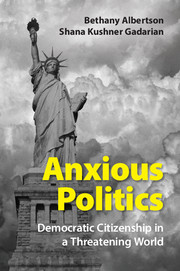Book contents
- Frontmatter
- Dedication
- Contents
- List of Tables
- List of Figures
- Acknowledgments
- Prologue
- 1 Anxiety in Democratic Life
- 2 What's Your Worry?: Finding and Creating Anxiety in the American Public
- 3 Anxiety, Immigration, and the Search for Information
- 4 Don't Worry, Be Trusting?: The Effect of Anxiety on Political Trust
- 5 The Politics of Anxiety: Anxiety's Role in Public Opinion
- 6 Anxiety and Democratic Citizenship
- Appendix
- References
- Index
5 - The Politics of Anxiety: Anxiety's Role in Public Opinion
Published online by Cambridge University Press: 05 September 2015
- Frontmatter
- Dedication
- Contents
- List of Tables
- List of Figures
- Acknowledgments
- Prologue
- 1 Anxiety in Democratic Life
- 2 What's Your Worry?: Finding and Creating Anxiety in the American Public
- 3 Anxiety, Immigration, and the Search for Information
- 4 Don't Worry, Be Trusting?: The Effect of Anxiety on Political Trust
- 5 The Politics of Anxiety: Anxiety's Role in Public Opinion
- 6 Anxiety and Democratic Citizenship
- Appendix
- References
- Index
Summary
This is a time when we're faced, not with a nation that is – that is extraordinarily secure in a very, very calm world. We're facing a very dangerous world.
Mitt Romney, 2011, New Hampshire GOP Primary DebatePoliticians regularly sound alarm bells. To listen to contemporary political debates, immigrants are taking hard-working Americans’ jobs, terrorists are getting past our defenses, and we are irreversibly destroying our environment for future generations. It is a very dangerous world. If we think back to two of the most memorable presidential advertisements, LBJ's 1964 Daisy ad and the 1988 Willie Horton ad, both have strong elements of fear. The Daisy ad confronts viewers with a nuclear war while the Willie Horton ad warns of a world where lax law enforcement allows dangerous criminals out on weekend passes. Both ads are designed to scare viewers and urge them to choose the safer option. Our purpose here is not to evaluate the veracity of any particular threats but to evaluate how people react to political alarms. In previous chapters, we explored the effects of anxiety on learning and trust and found that anxiety biases learning and the kinds of leaders that we trust in systematic ways. So far, we have not addressed the basic public opinion question – what sorts of policies do anxious people support? This final empirical chapter is devoted to the attitudinal consequences of anxiety.
We argue that anxiety can trigger support for protective measures. In each section, we draw specific hypotheses about how protection is manifest across the four policy areas: public health, immigration, terrorism, and climate change. Policies can be considered protective based on the quality of the policy, because political leaders frame them as such, or because few opposing policies effectively challenge them. These four cases provide examples of policy areas with clear best protective practices (public health) and where elite frames shape views of what constitutes protection (immigration, terrorism, climate change). These policies also vary in their connection to partisan politics. How to tackle disease outbreaks is less contentious on partisan grounds than is the best way to stem illegal immigration flows or prevent future terrorist attacks, where “best practices” tend to depend on the party advocating the policy. In three of the policy areas (immigration, terrorism, climate change), one party's ownership creates an advantage for its preferred protective policy.
- Type
- Chapter
- Information
- Anxious PoliticsDemocratic Citizenship in a Threatening World, pp. 100 - 137Publisher: Cambridge University PressPrint publication year: 2015



